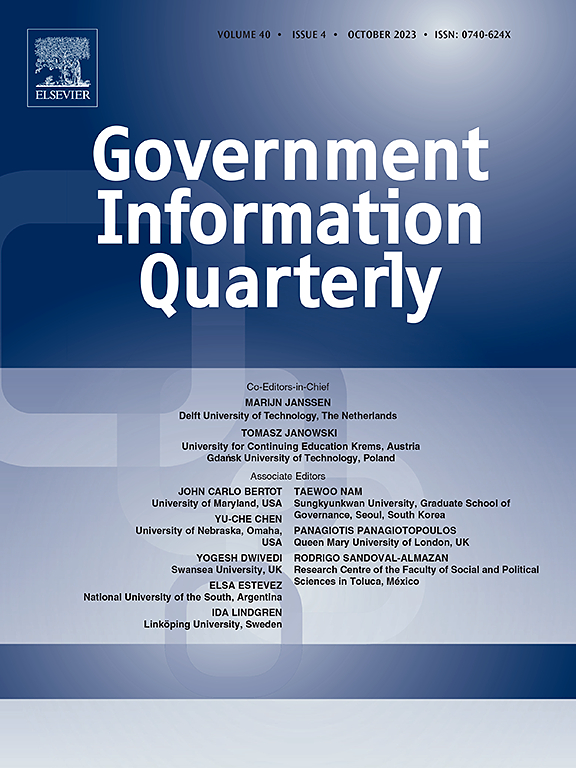电子政务研究中隐喻的使用与误用
IF 10
1区 管理学
Q1 INFORMATION SCIENCE & LIBRARY SCIENCE
引用次数: 0
摘要
隐喻通过使用相对熟知的、具体的和简单的概念来解释相对陌生的、抽象的或复杂的概念。由于电子政务是一个复杂的、多方面的现象,人们使用了许多隐喻来理解和解释电子政务是什么以及它是如何发展的。然而,隐喻在电子政务研究中的应用及其功能尚未得到系统的详细考察。在文献中弥合这一差距是必要和重要的,因为隐喻在电子政务专家和公众之间以及具有不同学科背景的电子政务学者之间具有特定的沟通功能。本文考察了电子政务文献中显性隐喻的使用。为此,我们首先通过对文献的系统回顾来识别不同的隐喻。然后,分析了在电子政务研究中使用隐喻的原因、作用、收益和风险。研究结果揭示了电子政务研究中的五种隐喻类型(照明、暗化、简化、翻译和操纵)。研究结果表明,隐喻可以帮助学者们在他们之间创造一种共同的语言,并简化复杂思想与公众的交流。对于实践者来说,不同的隐喻可以提供对电子政务的见解,并有助于将隐性知识转化为显性知识。然而,必须谨慎避免使用可能导致误解和资源效率低下的隐喻。最终,隐喻的成功取决于它在不同语境中有效传达概念的能力,这突出了在交际中谨慎使用和上下文敏感的重要性。最后一节提出了进一步研究的建议,包括检查隐喻在不同环境下使用的结果和影响。本文章由计算机程序翻译,如有差异,请以英文原文为准。
The use and misuse of metaphors in e-government studies
Metaphors explain relatively unknown, abstract, or complicated concepts by employing relatively better-known, concrete, and simple ones. Since e-government is a complex and multi-faceted phenomenon, many metaphors are used to understand and explain what e-government is and how it evolves. However, metaphors used in e-government studies and their functions have not been systematically examined in detail. Bridging this gap in the literature is necessary and important because metaphors serve specific communication functions between e-government experts and the general public, as well as among e-government scholars with diverse disciplinary backgrounds. This article examines the use of explicitly-used metaphors in e-government literature. To this end, we first identify different metaphors through a systematic review of the literature. Then, the reasons for, functions of, and benefits and risks associated with metaphor use in e-government studies are analyzed. The findings uncovered five types of metaphors (illumination, dimming, simplification, translation, and manipulation) in e-government studies. The findings reveal that metaphors can help scholars create a shared language among themselves and ease the communication of complex ideas to the general public. For practitioners, different metaphors can provide insights into e-government and help translate implicit knowledge into explicit. However, caution is necessary to avoid manipulative uses of metaphors that could lead to miscommunication and resource inefficiencies. Ultimately, the success of a metaphor hinges on its ability to effectively communicate concepts in various contexts, highlighting the importance of careful and context-sensitive usage in communication. The final section offers suggestions for further research, including examining the outcomes and impacts of metaphor use in various settings.
求助全文
通过发布文献求助,成功后即可免费获取论文全文。
去求助
来源期刊

Government Information Quarterly
INFORMATION SCIENCE & LIBRARY SCIENCE-
CiteScore
15.70
自引率
16.70%
发文量
106
期刊介绍:
Government Information Quarterly (GIQ) delves into the convergence of policy, information technology, government, and the public. It explores the impact of policies on government information flows, the role of technology in innovative government services, and the dynamic between citizens and governing bodies in the digital age. GIQ serves as a premier journal, disseminating high-quality research and insights that bridge the realms of policy, information technology, government, and public engagement.
 求助内容:
求助内容: 应助结果提醒方式:
应助结果提醒方式:


